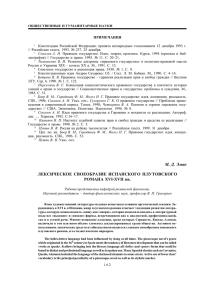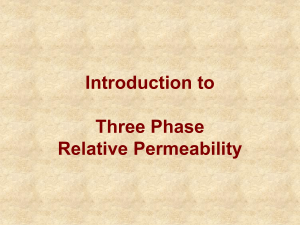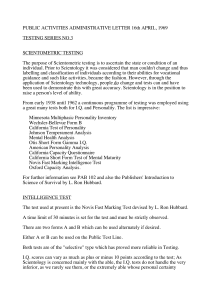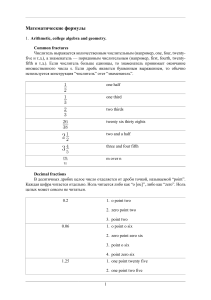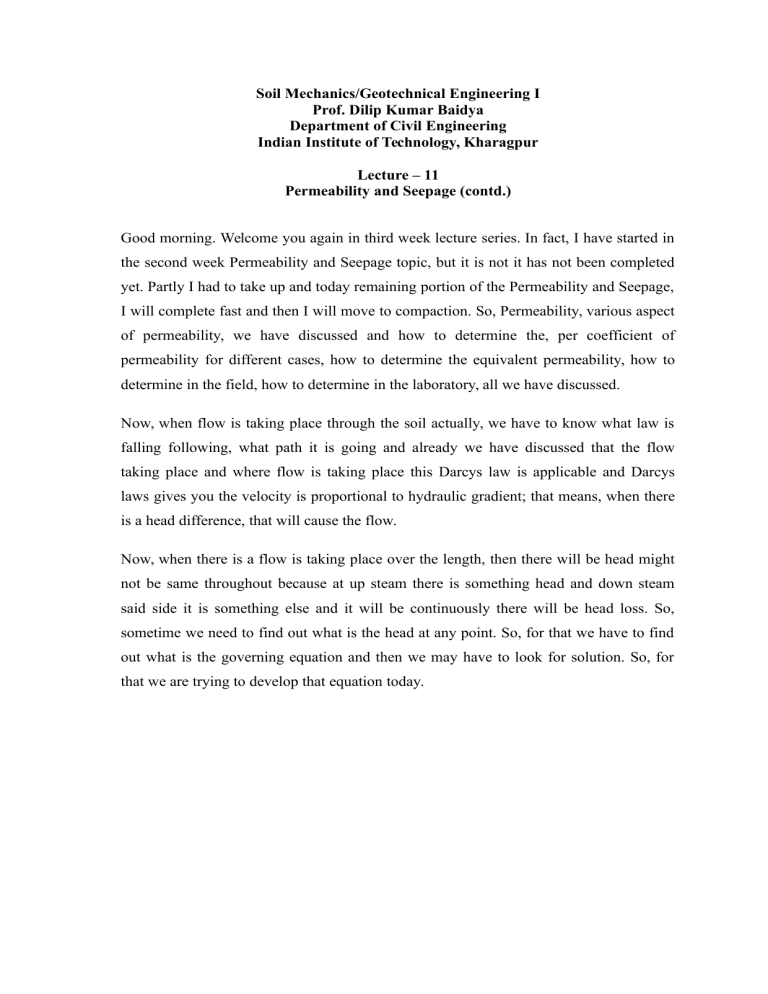
Soil Mechanics/Geotechnical Engineering I Prof. Dilip Kumar Baidya Department of Civil Engineering Indian Institute of Technology, Kharagpur Lecture – 11 Permeability and Seepage (contd.) Good morning. Welcome you again in third week lecture series. In fact, I have started in the second week Permeability and Seepage topic, but it is not it has not been completed yet. Partly I had to take up and today remaining portion of the Permeability and Seepage, I will complete fast and then I will move to compaction. So, Permeability, various aspect of permeability, we have discussed and how to determine the, per coefficient of permeability for different cases, how to determine the equivalent permeability, how to determine in the field, how to determine in the laboratory, all we have discussed. Now, when flow is taking place through the soil actually, we have to know what law is falling following, what path it is going and already we have discussed that the flow taking place and where flow is taking place this Darcys law is applicable and Darcys laws gives you the velocity is proportional to hydraulic gradient; that means, when there is a head difference, that will cause the flow. Now, when there is a flow is taking place over the length, then there will be head might not be same throughout because at up steam there is something head and down steam said side it is something else and it will be continuously there will be head loss. So, sometime we need to find out what is the head at any point. So, for that we have to find out what is the governing equation and then we may have to look for solution. So, for that we are trying to develop that equation today. (Refer Slide Time: 02:11) That is equation flow, equation of flow through soil. And for that we are taking one element here and this is the element and which is having dimension dx, dy and dz and it is at the depth from the ground, it is h. And you can imagine that flow is taking place from all 3 direction, flow is in this direction, flow from this direction and flow from this direction. And in that case we will try to mathematically we will see this and finally we will arrive at the equation. (Refer Slide Time: 03:13) And this is the flow. When this flow is taking place suppose in the x direction, the component of hydraulic gradient i x, we can say the hydraulic gradient 3 to the power i x i y and i z at the center of the element; that means, if element I have taken something like this and this is the midpoint and I can if I this is the dx length. So, this side dx by 2, this side dx by 2 so, we are applying the equation at the midpoint and in that case i x mathematically is derivative of h with respective to x and it is negative sign because head loss is there in the direction of flow. The rate of change of hydraulic gradient that means, del i x del x that means, how it is changing that is I have mentioned that flow head loss will be there continuously. So, you know rate of change that is in 1 second you can differentiate this i x. So, that will be the drew thing and then if I do that, then I will get the this expression and this del to del x and hence the gradient at the face of the element nearest to the origin, that means, before that means, before the midpoint and after the midpoint, I consider the nearest is the before the midpoint. Then it will be original was this and this is the change. There is a bracket marks say missing. So, otherwise this is the one, del i x del x in minus into minus take dx by 2 because what that was distance and negative direction. So, ultimately if I simplify we will get this. (Refer Slide Time: 05:10) Now, similarly I can find out flow from the Darcys law q equal to AK i and a is nothing but when is flow is taking place in the x direction, flow will be across section in y and z. So, that is why dy and dz is the area, k is there and this is the i. So, we have got the, then this is the flow and similarly the gradient at the farthest from the origin that can be again similarly, this can be obtain minus del h del x plus this, so it will be this expression and. Therefore the flow will be this is i and then correspondingly similar to this, for flow this is the expression. So, we have got question equation 1 and equation 2. One is the flow in nearest and one is the furthest; that means, this represents nothing but flow in and flow out. (Refer Slide Time: 06:24) The expression 1 and 2 represents respectively the flow into and out of the element in the x direction. So, net rate of increase of water within the element that is nothing but the net rate of change of volume of the element and that is 1 minus 2. And if I do the previous equation 1 and equation 2, I will get this expression. So, k x del 2 h del x square dx, dy, dz, this is the volume actually volume of the element and this k x into del 2 h del x square, additionally we are getting. This is the change of volume in the x direction or net of flow. The way we have done for x direction we can do also similarly for y and z direction and if I add all 3, then similar expression we obtain when y z direction are the sum of the rates of change of volume in 3 direction gives the rate of change of the volume total volume. So, I have got x directions, similar procedure following similar procedure again for y direction, I can get for z direction. All 3 can be added that will be giving you total change of volume and so that if I add this, everywhere dx, dy, dz will be there should be taken out and this initial part; this one for x direction, this one for y direction, this one for z direction. So that means, this will be the total equation for change of volume. (Refer Slide Time: 08:14) Now, we know that under the laminar flow condition that apply in seepage problem, there is no change in volume and the above equation must equal to 0. So, that since there is no change in volume, total x, y, z whatever total quantity you have got, that can be equated to 0. So, if I do that then I am getting this is the equation. Equation 3 is the general expression for the 3 dimensional flow. If the soil is isotropic that means, k x equal to k y equal to k z equal to k; that means, all 3 direction like kx, ky and kz and this can be all can be written as k, that means all direction coefficient of permeability same then this can be taken as k and if I put k everywhere, then k cannot be 0. So, ultimately the other expression will be k will be taken out and after taking out either k can be 0 or remaining portion will be 0. Since k cannot be 0, remaining portion has to be 0. (Refer Slide Time: 09:23) You can see based on that, I can get this equation, that means this is the final expression I am getting, del 2 h del x square plus del 2 h del y square plus del 2 h del z square equal to 0. This is the expression I am getting when is isotropic condition and in many seepage problem, we sometime instead of handling 3 dimension, we handle 2 dimension, 1 dimension. We can take it 0 and then this expression will be reducing to if the generalize form 2 dimension, this is the equation. And if it is the isotropic condition 2 dimension, this is our equation. And so, an isotropic, we are using the term isotropic again and again, the isotropic means what the soil whose material properties are the same in all direction. So, this is the equation. Now either solving this equation or solving this equation or even if I can make it further simplified, I can make del 2 h del x square equal to zero that means, it is a 1 dimensional. So, this type of equation either this or this or this can be solved actually mathematically and then applying various boundary condition, we can find out the if I integrate this one twice, then we will get 2 constants and those 2 constants can be obtained by applying boundary conditions. So, there is a procedure for solving this problem for many geotechnical problem, we solved this equation. Earlier use to do some ways, nowadays because of the availability of computer application, we can programme it and do it. Perhaps uh we will not be able to go in details about the solution of this, but what we do actually in practice, I will try to discuss about that. (Refer Slide Time: 11:26) So, now that was the equation that Laplace equation that we have got. And that typical Laplace equation derived and expressed in terms of 2 conjugate functions, that will be that equation also can be expressed in 2 conjugate function. One is phi, another is psi. Phi actually potential function and flow function. And this are ultimately, these 2 function the such a way we can prove that these 2 function again they actually meet each other at right angle, that can be also proved, but we are not going to that only thing is that this phi and psi follow Laplace equation that can be shown. So, you can see, we can assume that del phi del x equal to v x and which is equal to k i x as per Darcys equation. So, this is the one and that will be again minus k del h del x. Suppose in the x direction, similarly del psi del z equal to v z and as per Darcys law, this one. So, these 2 we are getting, del phi del x is equal to this and del psi del z equal to this. Now, if you differentiate once again this one and differentiate once again this one, del square del 2 phi del x square if I do, then I will get k del 2 h del x square and if I differentiate once again here, del 2 phi del z square, I will get minus k del 2 h del z square. And now this del 2 phi del x square and del 2 phi del z square if I do, then I will see it because of this is minus sign and this is plus sign. So, this it will get cancelled and finally, I think there is a mistake this should be there this may not be minus sign. So, these 2 together finally, summation will be zero; that means, the phi function the way we have selected that also follow Laplace equations. (Refer Slide Time: 13:41) Now, similarly the psi function, also you can take psi del psi del z equal to v x, which will be equal to minus k again from Darcys law equal to this. And minus del psi del x is equal to v z and that will be again minus del h del z. Now this one again if now if I compare with phi function and then we can see that, del phi del x is equal to del psi del z and del phi del z equal to minus del psi del x. Now, if I do del 2 psi del x square, this one if I differentiate once again. So, I will get this one and if I differentiate this one twice once again, then I will get this one. So, these 2 again these and this if I now add then finally, I will get this expression; that means, this is equal to this is also Laplace equation. That means, the function we have taken phi and psi, they also follow Laplace equation. And this Laplace equation is called this phi and psi function, one is a potential function and another is flow function and this can be shown later on that there are function is such that the when they meet, they meet at right angles to each other. (Refer Slide Time: 15:09) Now, in the Permeability and Seepage issues, then finally what we have to do. We have to most likely, most of the time we have to estimate the seepage flow quantity. And for that actually whatever equation you have derived that can be solved by mathematically then we all have obtained. But it is generally is a complex one. So, because of that conventionally, in geotechnical engineering, we use one graphical method very quickly we can do it without going through the details mathematic. Of course, mathematics will be there in the background because whatever condition it satisfy, that the graphical also conditioning satisfying those condition only you have to do it. So, for that actually we generally use a flow net and in the flow net, actually is a flow net is the combination of uh lines and one set of line is flow line another set of lines are called equipotential line. Now, what is Flow line? Flow line is a line where the path, which water particles follow in the course of seepage are known as Flow lines. Then water flows from points of high to low head, then always water will flow from higher elevation to lower elevation and the lower head makes smooth curves when the changing direction. Hence one can draw a series of smooth curves representing the paths followed by a moving water particles we can, up stream side we can consider at a point and that point suppose we allow with water moving, then stressing that point I can draw a line smooth line that will be equipotential like that, like that number of them I can think at different location and I can draw number of flow line. Similar to that Equipotential line, as the water moves along the flow line, it experiences a continuous loss of head; that means, when we are starting from at a higher head, but when water is moving in this direction and whatever head was here same head will not be here. So, there will be because of this process of this flow, there will be loss of head will be there. So that means, different below the water body earth returning structure below which water is flowing, if I can draw the head or potential at different points and finally if I join the points of equal potential, then I will get Equipotential line. So, definition of Equipotential line is the line joining the points of equal potential. So, that is what, as the water moves along the flow line it experiences a continuous loss of head. If we can obtain the head causing flow at points along a flow line by points of equal potential joining the points of equal potential, one can obtain the second set of line known as Equipotential line. So, these 2 flow line and equipotential line, one can get and this is a definition of flow line equipotential. (Refer Slide Time: 18:31) Now Flow Nets as I have already mentioned that, it is come in a number of equipotential line or flow line combining them and drawing when you draw in a particular pattern or following a particular law that is actually Flow Net. The flow of water through soil can be represented graphically by a flow net, a form of curvilinear net made up of flow lines intersected by a set of equipotential lines. So that means, this is the flow line that is it will be a curvilinear net made up of flow lines and intersected by set of equipotential lines. So, there will be equipotential line and there will be flow line and they will intersect that there will be a mesh like things will be prepared that that is called Flow Net. And that Flow Net can be utilized for calculating the amount of seepage through the body. (Refer Slide Time: 19:35) So, this is example, not example really. We can draw we have drawn the flow net here following particular procedure. This is the suppose structure, dam structure and water head is h and here actually head is 0, head is here h and here head is 0. So, under this situation actually along this length actually, head will be constant. So, this is the equipotential line similarly here also head is constant. So, that is also equipotential line. And then, this is one flow line and water can also flow along this. So, this will be another flow line and flow line and I can imagine this is, since it is equipotential line, I can imagine one point when moves from this side to this side, it will move like this, not exactly this way straight. So, it will go in the curved way and it will go move this way. If we want point from here moves from this side to this side, it will move from here to here this like this way. Similarly point from here moves this to head to this side, it will move this way. And now, I can imagine a number of equipotential, say here is total head here and head is 0. That means, head h is lost when it is from moved from here to here. So, here it is h will be h itself and this one it will be slowly reducing at different points. So, I can make it equidistance. I can make it sorry this is this is the end of flow line. So, this is the flow I can allow this is constant. So, this is the from, loss from here to here, loss from here to here, loss from here to here. It will be equal that accordingly I can plan. And then it is not very simple to draw this one, you one only one thing you one. The one has to remember that, this is the flow line, this is a flow line, this is a flow line, this a flow line, there is a flow line here and there is a flow line here. So, similarly these are of equipotential. This is equiponential line. This is these are all equipotential line, these are equipotential line, equipotential line, equipotential line and this is also equipotential line, this is also equipotential line. So now, this only one thing to be remember that flow line and equipotential line they intersect each other at right angle this is one thing to be remembered and there is another guideline which I will mention in later. So, this based on that one has to draw this and now using this, how to find out the seepage that has to be same. So from here, one element can be shown in a large view and that is actually, see this portion is suppose, this portion is suppose l and this portion is suppose b. So, l and b, the dimension and we from a flow line, I took only 1 element actually which is having length l and width b. And flow is taking pace place this direction, so what is the area through which a flow is taking place, b times 1. Suppose I take unit width, so b times 1 through which one flow is taking place. So, based on this now, I will see I will take another thing that is I am considering now 3 portion of blocks; one is this one, by ABCD. And I am taking in the same flow line a different location a 1, b 1, c 1 and d 1 suppose. So, the with respect to this, what is the relationship both the blocks in the same flow line. And similarly, I will take another one here, with respect to this what is the relationship here? They are within the same equipotential line. So, these 2 equipotential, this is the equipotential line, this is equipotential line. So, this block is there between 2 equipotential lines. Similarly this block also it is there between the same equipotential lines. So, if I do this compare with this and this and comparing with this and this, we will be able to reach some conclusion and that conclusion helps us help us to derive the flow equation, flow quantity. (Refer Slide Time: 24:09) So, while proceed to this, now you can see, the figure what are shows typical flow net representing sequence through a soil beneath the dam. The flow is assumed to be 2 dimensional sorry. And then the from the Darcys law, q equal to AK I and del q and since it is small union, then I can write it in each flow net, flow channel it is del q. So, del q equal to k times b into 1, actually is the through which it is passing and I is the, b if it is taking 1, it will become k b into i. Now, in figure ABCD is bounded by, as I have mentioned ABCD is bounded by the same flow line A 1 B 1 C 1 d 1 and again by the same equipotential as A,B,C,D. So, this is with ABCD, I will relate this one. Now with ABCD, I will relate this one. See if I relate this one, for any figure in the net del q equal to k del h into b by l and del h actually head loss between the 2 equipotential and l is the distance between the equipotential. (Refer Slide Time: 25:27) If I consider this, then you can see a flow through A 1 B 1 C 1 D 1, it will be del q 1, it will be k times del h 1 b 1 by l 1 and flow through A 2 B 2 C 2 del q 2 if I consider, then k del to del h 2 b 2 by l 2. And flow through ABCD, which I can say del q k del h b by l. Now I can draw the flow net in such a way, l 1 will be equal to b 1, l 2 by b equal to b 2, l by b; that means, what I have to do? I have to make the net in such a way that all blocks will be approximately square. They may not be of equal size, but each uh block if you look at, then it will it will look like a square only, approximate square. When you do that, then it will be b 1 by l 1, b 2 by l 2, b by l equal to 1. (Refer Slide Time: 26:26) And if that happens, then if that happens then square ABCD has the same flow lines as ABCD. So, del q must equal to del q 1. And since the square ABCD has the same equipotential as ABCD, then del h also will be equal to del h 2. That is another condition. So, this gives you del q 2 equal to k del h 2 equal to k delta h equal to again del q equal to again del q 1. Whatever we have derived del q equal to del 1 and this is since equal to del k delta h is equal to k del delta h and delta h 2. So, delta h 2 I can substitute by k into delta h. And k into delta h is nothing but del q from here and that del q also equal to del q 1. So, if that happens, del q equal to del q 1 equal to del q 2 and del h equal to del h 1 equal to del h 2. So, if I make the flow net with the square shape, then this happen at each drops will be delta h and each channel, the flow will be quantity, the flow quantity constant which will be equal to delta q. And if I consider that, then it will be everything will be simplified. (Refer Slide Time: 27:40) Then assume h total head and q is the total quantity of flow, then our delta h will be total head by number of drops and del q will be q by number of flow channels. Then f is the number of flow channels and N a is the number of flow drops. So, del q will be h delta h b by l, so k times delta h and again k into h by N d. So, this will be k times h by N d equal to q by N f q by n f is the delta f and k time del h by N d. So, this one, delta h is I can substitute by h by N d. So, k time del h by N d, k times h by N d and again del q equal to q by N f, these 2 be equated. If I equate that, that gives you q is equal to k times h into N f by N d where k is the coefficient of permeability h is the head loss of up steam to down steam, h is number of flow channel, flow channel already I have and this is number of drops. Number of equipotential drops, equipotential drop, so, that means, if I draw the flow net from there I can approximately find out how many flow channels and then I can count how many equipotential line I have drawn and based on that I can imagine how many potential drops. So, N f and N d will becoming from the figure and h also will be coming from the difference between the up steam and down steam head and k is the known property for the soil. So, if I know that, then I can find out the quantity of seepage. I think I can close here, I can rest of the things I can do in the next slide and maybe the next lecture ok. Thank you.
